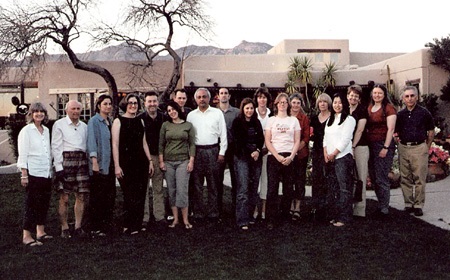Where the Wild Things Are Now
Date
Mar 12-18, 2004Organized by
Rebecca CassidyLocation
Hacienda del Sol, Tucson, ArizonaPublications
Where the Wild Things Are Now (Molly Mullin and Rebecca Cassidy, Eds.), Berg , Oxford, 2007.Participants
- Rebecca Cassidy Goldsmiths College, UK
- Nigel Clark The Open University, UK
- Keith Dobney University of Durham, UK
- Gillian Feeley-Harnik University of Michigan, USA
- Richard Fox Wenner-Gren Foundation, USA
- Agustín Fuentes University of Notre Dame, USA
- Helen Leach University of Otago, New Zealand
- Marianne Lien University of Oslo, USA
- Pamela McElwee Cornell University, USA
- Amanda Moore University of California, Irvine, USA
- Molly Mullin, organizer Albion College, USA
- Karen Rader Sarah Lawrence College, USA
- Nerissa Russell Cornell University, USA
- Kalyanakrishnan Sivaramakrishnan University of Washington, USA
- Yuka Suzuki Bard College, USA
- Peter Wilson University of Otago, New Zealand
ORGANIZER’S STATEMENT: In recent years, anthropologists outside archaeology have paid domestication little attention, while engaging in novel and challenging work on the production and reproduction of life forms. Now is an appropriate time for anthropologists of a variety of specializations to revisit domestication, taking advantage of the long history of work on this topic among anthropology’s sub-fields while responding to matters of significant public concern. The aim of this symposium was to rethink the concept of domestication in anthropology. If domestication proved too problematic a concept to describe present and future developments in relationships between humans and their environment, what are its possible replacements?
The main themes of the conference were laid out in an introductory session, in which the participants also introduced themselves and their work. Particular participants were asked to delineate the various uses of the concept of domestication within their sub-disciplines. Because this is an area of inter-disciplinary research, there followed a session that defined key terms and directions for the symposium. Areas of contrast and resemblance were noted and explored. It became clear during this session that the concept of domestication did not map easily onto a single process, action or set of events. However, commonalities between different uses of the term were uncovered, and these proved to be a useful starting point for further discussion.
Four sessions of paper discussion followed. In general, it was felt that a strictly temporal, biological, or otherwise definitive concept of domestication was complementary with, rather than antagonistic to, a more culturally specific concept. Those participants thinking about domestication as a process writ large in time and space were encouraged to think about events that seemed to be examples of domestication in particular contexts, but which failed to fulfil various apparently essential and fixed criteria. Conversely, those who had explored local understandings of processes described as domestication were able to place this understanding within a comparative framework. The combination of long-term historical perspectives with case studies of cutting edge contemporary phenomena was particularly productive, as were geographically and culturally diverse contributions.
The symposium culminated in a productive discussion of themes that had emerged during the meeting. The group felt that they had made great progress in thinking about complex questions, and in making connections between sub-disciplines. New areas of research and areas of collaboration were identified and existing knowledge was shared and augmented.
Wenner-Gren Symposium #133
